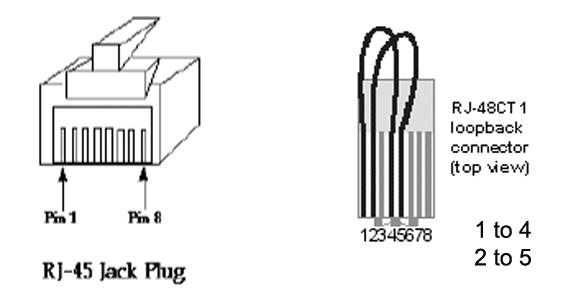

#RJ45 LOOPBACK PLUG SERIAL#

#RJ45 LOOPBACK PLUG CODE#
Make sure not to have VISA Test Panels and LabVIEW simultaneously open, or VISA will throw an access resource error (error code -1073807246 hex:0xbfff0072). Note: You can test communication in MAX VISA Test Panels or LabVIEW examples.

Select the communications port of interest under Devices and Interfaces.Open Measurement and Automation Explorer (MAX) from the Start menu.It is not recommended to use the RJ-50 connector by itself to perform a loopback test due to the small separation between pins. If you use a RJ-50 to DB-9 serial cable (Part Number 182845-XX), a loopback test can be performed using the pins for a DB-9 connector. The positive connections are indicated in red, the negative connections are indicated in blue, and the GND connections are indicated in green. Refer to the pins below based on your connector type.

From port 1 to port 2, wire the shorted positive signals together, and the shorted negative signals together.On each RS-485 port, place jumper wires between the TXD+ and RXD+ signals, and between TXD- and RXD- signals.The positive connections are indicated in red and the negative connections are indicated in blue.įor 2-wire configurations, you will need two RS-485 ports to achieve a setup similar to a traditional loopback test. On an RS-422/485 port, connect the TXD+ signal to RXD+ signal, and the TXD- signal to the RXD- signal. *It is not recommended to use the RJ-50 connector by itself to perform a loopback test due to the small separation between pins. If you use a RJ-50 to DB-9 serial cable (Part Number 182845-XX), a loopback test can be performed using the pins for a DB-9 connector. On an RS-232 port, connect the transmit (TXD) signal to the receive (RXD) signal. Note: If you are using a third-party serial interface, use this article based on your hardware pinout. For more details on NI Serial Hardware pinouts, refer to the Serial Quick Reference Guide. Note: The pin diagrams provided for this tutorial are for the female connector. RS-422/485) and the type of serial connector you have. Identify what serial communication protocol you are using (RS-232 vs. Refer to the sections below to properly connect your hardware.


 0 kommentar(er)
0 kommentar(er)
